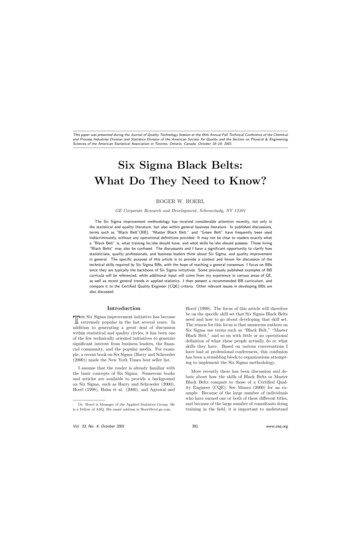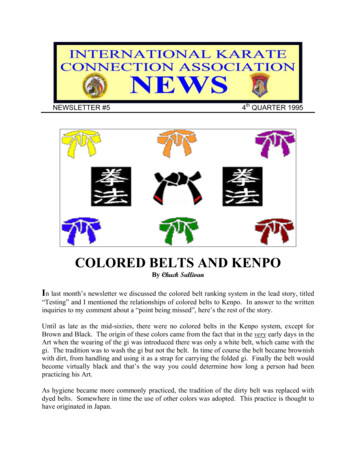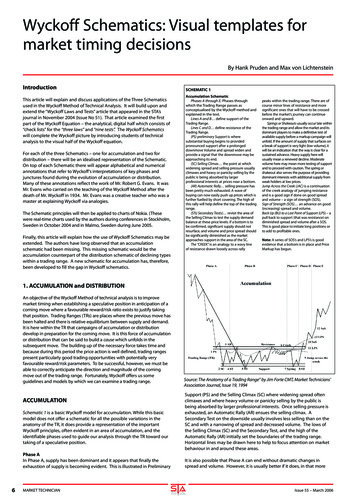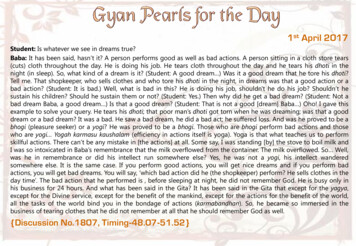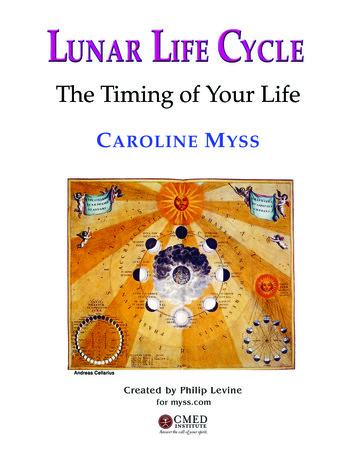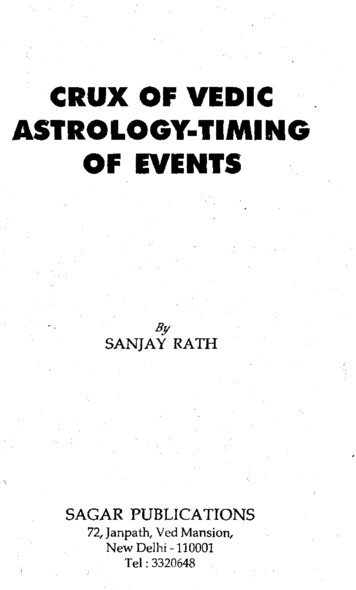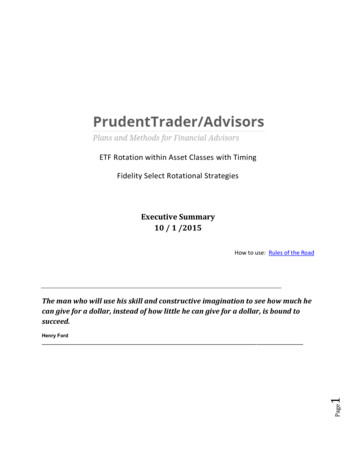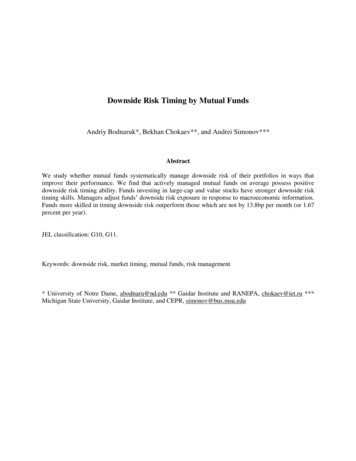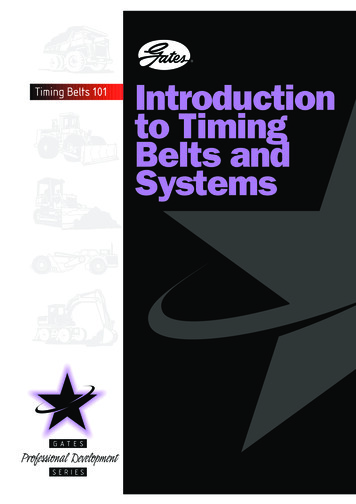
Transcription
timing Belts 101Introductionto TimingBelts andSystems
i n t r o d u c t i o nt ot i m i n gB e l t sa n ds y s t e m s1 0 1Table of ContentsIntroductionto TimingBelts andSystemsTiming System Overview. Page 2Engines. Page 4System Components. Page 6Belts. Page 8Failure Modes. Page 13Timing Belt Troubleshooting. Page 17PowerGrip Timing Tensioner Kits. Page 19
i n t r o d u c t i o nt ot i m i n gB e l t sa n ds y s t e m s1 0 1Timing System OverviewWhy a Synchronous Belt in Automotive Engines?Synchronous belt drive systems, used to synchronize cam and crankshafts, replaced the classical chain drives when overhead camshaftswere introduced into engine technology in the 1970s.A timing beltis a flat, toothedrubber belt thatsynchronizes anengine’s valve andpiston movement.The first belt was made of polyurethane with steel cord tension members.During ongoing developments, polyurethane was replaced by very strongand temperature-resistant rubber materials. In addition, the tensionmember was changed to fiber glass, which provided excellent flex and verylow elongation behavior. During further engine developments, supported by the trend to overheadcamshafts, synchronous (toothed) belt drive systems became morecommon in engines. This trend was also supported by the manyadvantages of toothed belt drives, including:nMore simple drivesnFlexible belt routingnLower costnLow elongation behavior and friction lossesnConstant timing over engine lifenLower fuel consumptionnLess emissionsTiming System Overview
i n t r o d u c t i o nt ot i m i n gB e l t sa n ds y s t e m s1 0 1Timing System OperationIn an engine, the crankshaft drives the camshaft(s) and actuates the valvesvia a belt or a chain. The timing belt is widely used by car manufacturersbecause of its advantages over chain, namely reduced space, as well aslighter and quieter running.If the belt tensionerpulley and idlerpulleys are notchanged togetherwith the belt, earlybreakdown mayoccur, resultingin serious damageto the engine.Today, one out of every five passenger cars and light trucks use a timing belt totransmit power from the crankshaft to the camshaft(s). Most 4-cylinder and V-6engines, as well as a few V-8s, use a timing belt. The timing belt is critical to theengine because it sets the engine’s intake and exhaust valves in motion.Note: Most belt drives on current production engines haverecommended change intervals of 160,000klms or more.Belt or Chain?The benefits of using a belt include:Efficiency A belt drive system can reduce up to 4.5 horsepower in friction loss.nn Less Vibration A chain drive system shows lower transmission error. A belt drivesystem can be optimized to be equal or better than chain.nReduced NoiseCreep/Wear Current belt technology provides less than 0.1 percent totallength change.nn Durability/Capability Similar applications with belt drive systems are proven in the industry.Package A belt drive system fits within the chain drive package.nn Weight A belt drive system can save approximately 1.5 kg/3.3 lbs. per engine.n Cost Overall costs of implementing a belt drive system are generallylower than chain.nTiming System OverviewComplexity A belt drive system uses less components and part numbers.
i n t r o d u c t i o nt ot i m i n gB e l t sa n ds y s t e m s1 0 1EnginesDesignOverhead cam (OHC) engines come in two types: single overhead cam(SOHC) or dual overhead cam (DOHC). These cams are driven by thecrankshaft by the use of a timing chain or a timing belt. There arelobes on the camshaft(s) that cause the exhaust and intake valvesto open or close. These lobes contact the valves directly or by theuse of cam followers. Despite their many differences, one thing alloverhead cam engines share in common is a need for good uppervalvetrain lubrication.OHC timing belts can snap unexpectedly at high mileage. Heat andfriction weaken the cords that reinforce the belt. The risk of failure goesup sharply after about 60,000 klm on most OHC engines built before themid-1990s. This is why Gates, along with most vehicle manufacturers,recommends replacing OHC timing belts for preventative maintenance at60,000-klm intervals.Starting in the mid-1990s, OHC timing belts made of more durablematerials began to appear with 90,000- to 100,000-klm replacementintervals. These new “long-life” belts, which are made of a specialhigh-temperature grade of rubber called highly-saturated nitrile (HSN),were first introduced by Gates. HSN extends belt life up to 50 percentor more, and reduces the need for periodic belt replacement.Gates was the firstto introduce timingbelts made of highlysaturated nitrile(HSN), a specialhigh-temperaturegrade of rubber. Engines
i n t r o d u c t i o nt ot i m i n gB e l t sa n ds y s t e m s1 0 1Free-Running or InterferenceAutomobile engines can be classified as either free-running orinterference, depending on what occurs if piston/valve synchronization islost.As illustrated to the right, in the free-running engine with the crankshaftstill moving, there is enough clearance between the valve and piston,even if the cam stops with a valve fully open.However, with interference engines there is not enough clearance betweenthe valves and pistons to prevent contact if the belt fails. Interferenceengines usually sustain damage if synchronization is lost.As illustrated, disrupted synchronization allows the piston and valve tocollide, causing damage and very expensive repairs for the vehicle owner.Damage can occur to valves, pistons or heads, and in some cases,completely ruin the engine.Most import (with higher compression engines) and car and light truckdiesel engines are interference. To avoid costly engine repairs, follow theauto manufacturers’ mileage replacement recommendations.Gates Timimg Beltand Timing TensionerKit Wall Chart(part no. 496-204)makes findinginterference easy.Balance Shaft versus Camshaft: 4-Cylinder EnginesFour-cylinder engines are attractive to vehicle designers because of theirshort, compact configuration. This allows them to be fitted transverselyinto the engine compartment, which frees up more space for passengersand cargo. In addition, short crankshafts and compact cylinder blockssave performance-robbing weight.However, when 4-cylinder engines grow larger than about two liters indisplacement, the second-order vibration (twice per engine revolution)set up by their pistons and connecting rods can become obnoxious.EnginesThe balance system consists of two parallel shafts on either sideof the crankshaft. Driven by a toothed belt, the balance shafts rotatein opposite directions at twice engine speed. Eccentric weights built intothe shafts generate inertial forces that counteract the second-orderforces.
i n t r o d u c t i o nt ot i m i n gB e l t sa n ds y s t e m s1 0 1System ComponentsTiming System Component IdentificationEngine timing systems utilize one or more of following components:idler or pulley, tensioner, hydraulic damper pivot arm and water pump.Tensioners and idlers are important components that workhand-in-hand with the timing belt. If there is damage to a timing belt,Gates recommends that these parts be changed as well. Belt damagecan occur from:nToo much or too little tensionnVibrationnHigh temperaturenBelt misalignmentWhen replacing any timing component, including tensioners, always referto the vehicle’s service manual.After installation, always take a few extra minutes to look over all thecomponents and check for proper operation. Make sure the pulleys rotatefreely, check the belt tension and make sure bolts are tightened to therecommended torque values.Idlers and PulleysThe timing belt system uses idlers and/or pulleys to either change thedirection of the belt or transmit power to a component such as a waterpump or oil pump. Pulleys and idlers are either:Smooth—located on the back side of the belt and typicallyused to change the direction of the belt to provide morewrap, or teeth in mesh, on a sprocket. They are also usedto break up long spans to prevent belt flutter. Notched—also called sprockets, are located on the toothside of the belt and exactly match the tooth profile of thebelt.Squeezing orcrimping a beltto a small radiuscan damage theinternal cords.Timing belts donot stretch, sonever attempt toforce one arounda pulley.Note: Do not mix or match sprockets from similar makesand models during replacement. Only replace sprocketsfrom a quality supplier for the specific application.Pulleys are constructed of metallic or plastic material and a sealedbearing. The pulley bearings are a “wear” item and must be changed atregular intervals. Bearings are lubricated with premium grease and sealedat the factory to extend bearing life. On used bearings, be sure to look forseepage from the pulley bearing and examine the condition of the seal. Ifyou’re ever in doubt, replace the pulley. Also, check the condition of thebearing by checking for “roughness” when turning. Never clean bearingsor add lubricants as this will shorten bearing life.System Components
i n t r o d u c t i o nt ot i m i n gB e l t sa n ds y s t e m s1 0 1TensionersTiming belt drives use three types of tensioning devices that must beinstalled per the vehicle manufacturer’s instructions: manual tensioner,spring loaded tensioner and hydraulic damper pivot arm.Manual TensionerManual tensioners use a tension spring toapply the initial tension. Hook one end of thespring to the tensioner and the other end tothe engine and tighten the tensioner bolts tothe proper torque (see Service Manual fortorque specifications).Automatic Spring-Loaded TensionerGates offers aneasy-to-use TimingBelt Tension Tester(Part No. 91000).This tester utilizesa compact design,measures timingbelts up to 30mmwide and costsmuch less thanmore complicatedtensioner testers.System ComponentsAlso known as a “frictional” tensioner, manufacturersare increasing their usage each year of the automaticspring-loaded tensioner because it provides a moreconsistent belt tension that can react and adjustto today’s high-revving engines. Gates carries anextensive line of these tensioners, many of which wereonly available through the OEM until now.Proper installation of these tensioners is critical and installationinstructions must be followed. Once installed, belt installation is generallyvery simple. In most cases a hexhead wrench is used to rotate thetensioner into a position that permits the belt to slip into place. Once thebelt is in place the tensioner is allowed to return to its operating position,applying the necessary tension.Hydraulic Damper Pivot ArmSeveral engine manufacturersuse a pivot arm in correlationwith a hydraulic damper totension the belt. This damperuses a piston that pushes a pivotarm with a pulley, providing the requiredtension. When re-using the hydraulicdamper, the piston will need to be driven backinto its cylinder and locked in place. A vice can be used to retract thepiston. Simply remove the damper from the engine, place it between vicejaws and slowly compress the piston. Once compressed, line up the holesin the piston with the holes in the cylinder and insert a pin to hold thepiston in place. The Gates Pin Set is the only tool created just for thispurpose (Part No. 91010).NOTE: Proper tensioning of timing belts is very critical. Please refer to page18 of this guide for more information.
i n t r o d u c t i o nt ot i m i n gB e l t sa n ds y s t e m s1 0 1BeltsTooth ProfilesThe earliest timing belts had a trapezoidal tooth profile. Competitionand more demanding applications led to the development of a curvilinearprofile. This in turn, evolved into a modified curvilinear profile. Beltswith different tooth profiles are not interchangeable. Gates has the mostcomplete timing belt line available, with more than 450 part numbers.The line includes both neoprene and HSN (highly-saturated nitrile)constructions, and all three tooth profile types:n Trapezoidaln Curvilinearn Modified CurvilinearNeoprene was standard until 1985, when Gates introduced the first beltsmade of HSN. In short supply, and difficult to engineer, HSN was thematerial of choice for most new timing belts. An HSN-constructed beltappears no different than a neoprene belt, but significantly outperformsin the high-temperature engine compartments of modern vehicles.In 2000, OEMs began using upgraded materials in timing belts,and Gates followed on aftermarket belts. While the name remained thesame, this newer HSN is higher-grade on all drives requiring an upgrade.Rubber was not the only improvement made to timing belts; the cordand jacket material were upgraded as well.Construction/Materials Today’s timing belts are highly sophisticated. The days of generic timingbelts made of standard materials and tooth profiles are gone. Improvednew generation belts are providing the extended durability and smootherperformance characteristics required by today’s engines. Gates leads theworld in timing belt technology, assuring customers a replacement beltto match the capabilities of the original belts.There are severaldifferent toothshapes used byGates and othertiming belt suppliers. Some lookvery similar to oneanother but aredifferent enoughto drasticallyreduce the lifeof the timing beltif the wrong toothshape is used.Belts
i n t r o d u c t i o nt ot i m i n gB e l t sa n ds y s t e m s1 0 1High-StrengthTensile CordHNBR ElastometricCompoundImprovedTooth JacketHNBR (or HSN) Elastomeric CompoundWhile it is important to inspectbelts whenever avehicle comes infor service, it’s notalways possibleto tell if a belt isstill good by visualinspection alone.n Forms the main body of the beltn Formulated for better heat resistance and durabilityn Wide temperature range (-40 C to 140 C)n Crack resistantHigh-Strength Tensile Cordn Designed for high-tension applicationsn Normally S- and Z-twisted to prevent “tracking”n High flexibilityn Heat resistantn Fatigue resistantn Low creep or zero-stretchImproved Tooth Jacketn Engineered for improved wear resistancen Abrasion resistantn Heat resistantn Fatigue resistantExpected Belt LifeToday’s belts operate under heavier loads and are exposed to manyfactors that may cause premature failure, including: heat and temperaturefluctuations, water, dirt, grease, oil and other environmental contaminants.In addition, hotter, smaller engine compartments put more stress on beltsand components. Idling time in traffic also takes a major toll on belt life.The engine runs hotter, and belts can break down much more rapidly in acar exposed to sustained periods of stop and go driving.BeltsSometimes, the first indication of a faulty belt is a squeaking noisecoming from the engine compartment. While a warning of a possiblemalfunction, this noise is not a precise indicator. Therefore, it isimperative to inspect belts whenever a vehicle comes in for service.If there is ever any doubt, recommend replacement of the belts. Thealternative could be a customer stranded in the middle of rush hour with abroken belt and a disabled vehicle.
i n t r o d u c t i o nt ot i m i n gB e l t sa n ds y s t e m s1 0 1OEM Recommended Replacement IntervalsWhether your customer’s vehicle utilizes a free-running or interferenceengine, timing belt failures can be avoided by adhering to the OEMrecommended replacement intervals and preventative maintenance.Most OEM-quality belts can be expected to last at least 100,000 klms, aslong as there are no problems found with the other components that maycause premature system failure. Also, severe conditions such as towing,aggressive driving and maintenance history need to be considered.Be aware that some manufacturers do recommend inspecting the timingbelt without specifying a replacement interval. Gates does not advise this,as many timing belts that have failed or are about to fail may look asnew as the day they were installed. Even if the belt doesn’t look cracked,worn or oil-contaminated, it should be replaced at a reasonable mileageinterval.Gates PowerGrip Timing Belt Manual contains a timing belt replacementinterval chart by application.NOTE: A timing belt should be replaced, regardless of mileage, if it hasbecome contaminated with engine oil or if it shows signs of prematurecracking, shredding or general wear.Customer Timing Belt Q&ASince timing belts are inside the engine, they tend to be an out-of-sight,out-of-mind item and are seldom thought of as a part of routinemaintenance. Here are some questions to ask customers that will helpsell belts and protect the customer from expensive repairs:1. D id you buy the car new?If yes, they’ll know if the belt has ever been replaced.A timing belt systeminspection shouldbe performed withany other underhood service on anengine with 50,000klms or more.2. Did you buy the car used?If so, they won’t know if the belt has been replaced. This is a flagfor the customer to get the belt checked, replaced or at least beaware that they have a timing belt.103. How many miles are on the vehicle?Generally belts should be replaced at around 100,000 klms or less.Gates Timing Belt Replacement Mileage Wall Chart (Product No.428-0408) is an excellent tool for determining replacement intervals.4. Have you ever replaced the timing belt?If the answer is “yes” or “no” (and the customer knows the mileage),you can determine where the vehicle is in the replacement cycle.Belts
i n t r o d u c t i o nt ot i m i n gB e l t sa n ds y s t e m s1 0 1Comparing OEM and Aftermarket BeltsTiming belt applications have increased dramatically. There are now morethan 700 models of Australian and foreign-made cars and light-duty truckswith overhead cam engines using timing belts. This dramatic number oftiming belt applications is the result of auto makers satisfying motorist’sdemands for spirited, responsive vehicles powered by efficient, multi-valveengines.Gates timing belts are designed to handle the wide speed range andconstant, synchronous drive power requirements common with theseengines. When an engine is prepared for introduction into the marketplace, the timing belt is “engineered” for that particular engine.Each timing belt part number offered by Gates represents a timingbelt designed to work for a specific engine. One belt cannot fit multipleengines. A different Gates part number indicates the belt is “unique” andis different than all the other part numbers.The aftermarket timing belt must be as good as or better than the OEMtiming belt. When a new part number is released by Gates, we matchthe OEM belt for fit, form and function. The Gates aftermarket timingbelt is thoroughly researched so that it matches the OEM for:n Tooth profilen Physical dimensions (length, width, etc.)n Materialsn Timing marksn Manufacturing requirementsAll these attributes are very important, and since Gates is the leaderin the supply of timing belts to the OEM, we are able to offer the samebelt in the aftermarket.Physical DimensionsThe dimensions of the timing belt are very important and must be closelymaintained in order to function on the engine. A belt that is too longor short will not allow the tensioning device to operate in the intendedrange for which it was designed. This will result in excessive noise oreven premature failure. Gates timing belts are manufactured with strictadherence to tolerances for all physical attributes.Belts11
i n t r o d u c t i o nt ot i m i n gB e l t sa n ds y s t e m s1 0 1MaterialsThe three main rubber compound designat
wrap, or teeth in mesh, on a sprocket. They are also used to break up long spans to prevent belt flutter. Notched—also called sprockets, are located on the tooth side of the belt and exactly match the tooth profile of the belt. Note: Do not mix or match sprockets from similar ma
